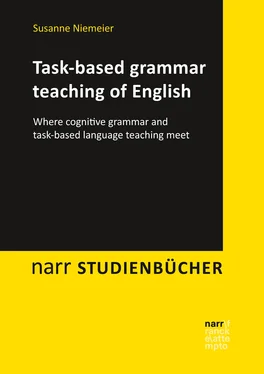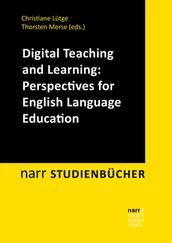The probably best researched category in linguistics is that of colour. Although all humans have the same organs for colour perception, the number of basic colour terms varies between languages. Following the classic BERLIN/KAY research (1969), cultures have between two and eleven (later on changed to twelve1) basic colour terms, which in English are black, white, red, blue, green, yellow, brown, grey, purple, pink and orange. All other colour names are seen as non-basic. Cultures for which colours are not that important in their daily life and environment have developed fewer terms. For example, the language Dani (from Papua-New Guinea) possesses only two basic colour terms. The more basic colour terms exist in a language, the better the language users’ colour memory is assumed to be, as the different categories provide different labels which lets the language user conceptualise these colours as more different than if they fell under the same label. However, the linguistic evidence for this is somewhat inconclusive.
The best example of a category is called its prototype – it is the image that somebody would draw (if asked and if given the necessary artistic skills) if they heard the category name. The status of prototype usually differs between cultures. For example, in a Western culture a table would be drawn as being relatively high-legged, whereas the legs would be a lot shorter in the Japanese culture. Prototype status is related to the relative frequency with which the entity in question occurs in a culture and it can also change over time, as today’s prototypical car is different from the prototypical car of the 1950s, for example. The non-prototypical members of a category share some features with the prototype but differ more or less from it in other respects and are therefore called marginal (or peripheral) members of the category in question. They can also vacillate between two neighbouring categories because the borders between categories are normally not exactly determined but remain fuzzy, at least to a certain extent.
Thus, to quote colours again, the colour turquoise is grouped by some people into the ‘blue’ category whereas other people put it into the ‘green’ category. Such category vacillation could never happen to a prototype, as, for instance, nobody would ever put a prototypical ‘red’ into a different colour category than ‘red’. To use another example: a dog will always be put into the ‘mammal’ category, whereas some people, especially children, might put non-prototypical mammals, such as whales or bats, into the ‘fish’ respectively ‘bird’ categories because they share properties with prototypical fish or birds (whales can swim, bats can fly and so on).
Grammar also possesses categories and prototypes. According to LANGACKER (2008: 79), “grammatical elements of any sort are likely to be polysemous2, having a prototypical as well as an array of other, less central values”. Word classes, for example, can be seen as categories, and, again, every category has a prototype. A prototypical noun (such as ‘house’) has time stability, whereas a prototypical verb (such as ‘to run’) has no time stability. As in every category, there are also less prototypical, i.e., more marginal members. The nominal entity ‘lightning’, for example, has no time stability, as a lightning only lasts for fragments of a second, but since the word is a member of the noun category, it is perceived as object-like. On the other hand, the event ‘to know’ is normally quite time-stable, but since the expression is a member of the verb category, it is still perceived as rather event-like. In the same way, grammatical constructions have prototypical usages and less prototypical usages, which traditional grammars call ‘rules’ and ‘exceptions’, the latter ones normally having to be learnt by heart. In the cognitive-linguistic view, however, the non-prototypical usages can still be explained via the prototype as they share some of its meaning. When teaching, it is of utmost importance to start with the prototypes and to later on develop the non-prototypical usages on the basis of a firmly established prototype.
3.1.4 Usage-based perspective
A further premise in cognitive linguistic theory is the notion that language is “usage-based”, which refers to a descriptive view of language and does away with the prescriptive view that the generativists still maintained (‘ideal speaker’). Although other linguistic as well as didactic paradigms call themselves “usage-based” as well, cognitive linguistics is presumably the most prominent example (cf. TYLER 2010). N. ELLIS/WULFF see two working hypotheses as a common denominator of all usage-based approaches to second language learning, namely that
(1) language learning is primarily based on learners’ exposure to their second language (L2) in use, that is, the linguistic input they receive [and] (2) learners induce the rules of their L2 from the input by employing cognitive mechanisms that are not exclusive to language learning, but that are general cognitive mechanisms at work in any kind of learning, including language learning. (N. ELLIS/WULFF 2013: 75)
As a consequence, a usage-based model of language does not aim at representing a linguistic system controlled by rigid rules but rather wants to “depict the complexity of language use” (TOMASELLO 2003: 5). In other words: cognitive linguistics aims at studying and representing language as it occurs in real life, as opposed to the abstract and context-free representations favoured by the generativists and also favoured by traditional textbooks and grammar exercises. A rule can never be a substitute for actually occurring instances of the construction in question. For the generativists, language use was relatively unimportant, as they were more interested in language structure. Cognitive linguistics has turned this view around, because it “considers the knowledge of language to be experientially based in actual speech” (GEERAERTS 2006:6), as words and grammar patterns do not occur on their own but are always part of actual utterances, actual conversations and actual speaker intentions.
Encompassing the complete lexis-grammar continuum, expressions and grammatical constructions are categorised by the language users according to their degree of abstractness and to the phonological, semantic and pragmatic associations between the linguistic units involved (cf. BYBEE 2008). These associations include information about form, meaning and the context of use, for words as well as for grammatical constructions. If words and constructions are used frequently, in so-called ‘usage events’1, the connections between them get strengthened (cf. ibid.: 216). LANGACKER (2008: 81), for example, recommends “providing the learners with sufficient exposure of representative uses of a given unit. Ideally, moreover, this exposure should occur in the context of meaningful exchanges approximating socially and culturally normal usage events”. Such exposure is meant to empower the learners and to give them the confidence to act native-speaker-like whenever they find themselves in situations that resemble the usage events they were exposed to in the foreign language classroom. This rationale is followed in all of the more practical teaching suggestions in the second part of this book.
3.1.5 Perspective on language acquisition
The principles outlined in the previous sub-chapter can be observed especially well in first language acquisition. Children acquire their native language by extracting information from the input they receive and accordingly build up their native language competence. Similarly, in an L2 classroom the teacher’s input is frequently taken as a model and helps to advance the learners’ interlanguage, and the more usage events of a particular grammatical structure the learners encounter the easier it is for them to adopt the structure into their L2. This has been nicely summed up by TYLER:
Читать дальше












